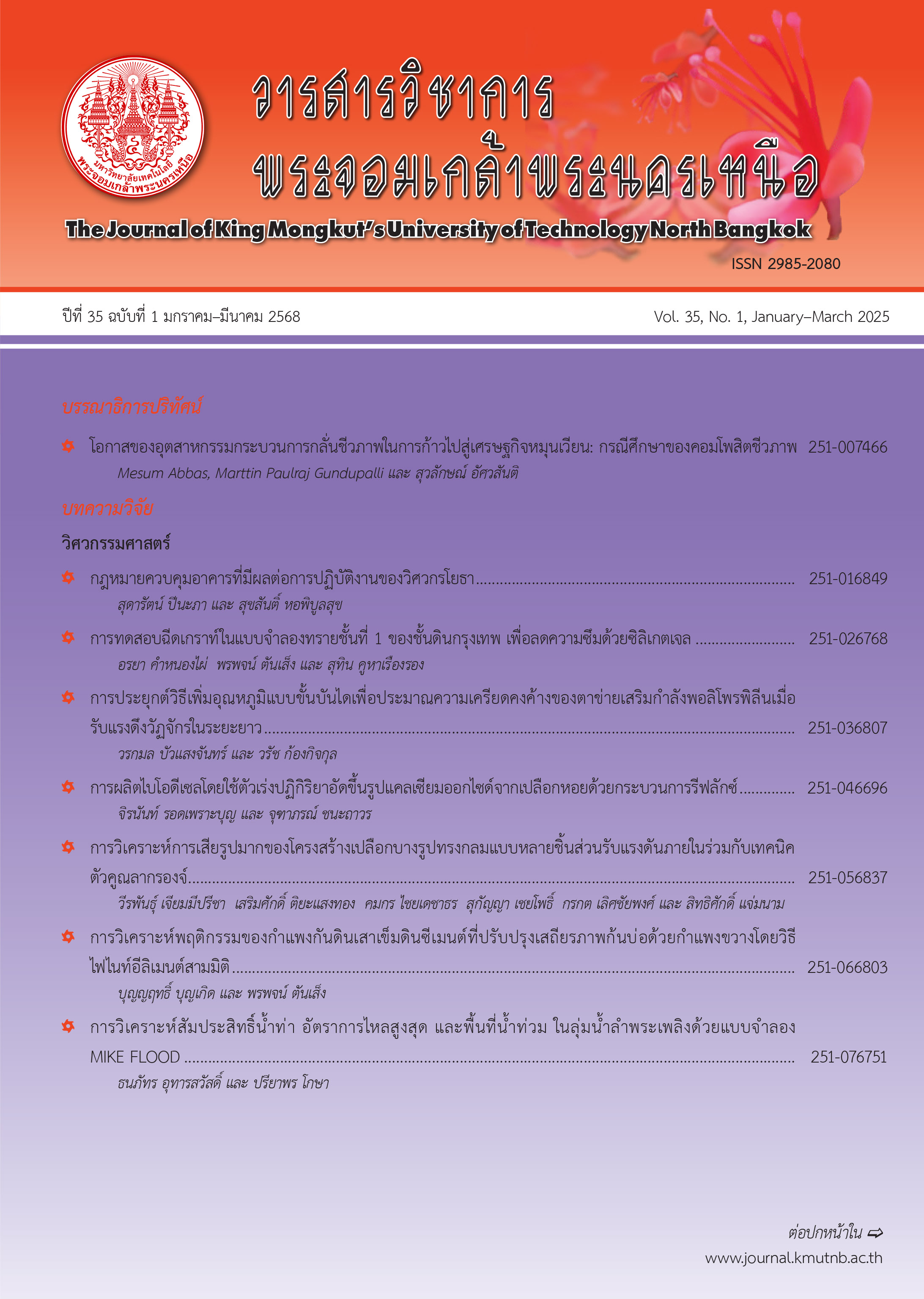Influence of Abrasive Waterjet Cutting on Efficiency of Cutting Rubber Floor Mats
Main Article Content
Abstract
The purpose of this research is to investigate the influence of high-pressure water cutting on efficiency of cutting rubber mats to develop into rubber puzzle mats. The cutting variables, i.e. abrasive mass flow rate, stand-off distance between a nozzle and the workpiece, water pressure and cutting speed were taken into account. The effects of cutting parameters on the subsequent quality, specifically surface roughness, kerf width and kerf bevel angle were explored. The three-level full factorial experimental design was applied to define optimization of cutting parameters (p<0.05) and ideal cutting conditions were observed. From the experiment, it was found that the abrasive mass flow rate factor, stand-off distance between nozzle and workpiece, water pressure and cutting speed have a significant influence on cutting characteristics. Optimal cutting conditions for 7mm thickness, 50–90 Shore A rubber puzzle mats were determined as follows: abrasive mass flow rate of 350 g/min, stand-off distance of 2 mm, jet pressure of 300 MPa and cutting speed of 2,000 mm/min. Practical applications of these optimal parameters for 10×10 cm rubber puzzle mats proved that cutting process could be completed within 3 minutes. This is acceptable for industrial manufacturing. The cut quality characteristics were exposed as 3.15 μm top surface roughness, 3.37 μm bottom surface roughness, 1.35 mm top kerf width, 1.28 mm bottom kerf width and 1.83 degree kerf bevel angle, respectively. The results of this study can prove beneficial to rubber mats manufacturers by increasing the value of rubber mats by post cutting process for creating rubber jigsaw mats.
Article Details

This work is licensed under a Creative Commons Attribution-NonCommercial-NoDerivatives 4.0 International License.
The articles published are the opinion of the author only. The author is responsible for any legal consequences. That may arise from that article.
References
Ministry of Commerce. (2023, January 10). Thailand's Natural Rubber Export Volume, [Online]. Available:https://tradereport.moc. go.th/Report/Default.aspx?Report=MenucomT opNCountry&Option=1&Lang=Th&ImExType=1
K. Phimchat, P. Pitayachaval, and N. Thammacho, “A surface effect of ceramic cutting using abrasive waterjet,” presented at the 10th South East Asian Technical University Consortium (SEATUC) Symposium, Shibauralinstitute of Technology, Tokyo, Japan, Feb. 22 – 24, 2016.
Industrial Product Standards for Rubber mats, TIS 2377-2551, 2008 (inThai).
Water Cutting Machine. (2022, May 12). Abrasive Waterjet Cutting. [Online]. Available: http://waterjetcutting.blogspot.com/2010/09/ abrasive-waterjet cutting.html
P. S. Na Ayutthaya and P. Luangpaiboon, Design and analysis of experiments. Bangkok: Top Publishing, 2008 (in Thai).
R. Prabu, K. M. Kumar, T. Maridurai, and R. Selvam, “Optimization of machining parameters during machining of austenitic stainless steel 304 in abrasive water jet machine,” International Journal of Mechanical and Production Engineering Research and Development (IJMPERD), vol. 8 no. 3, pp. 1191–1201, 2018.
M. Monno and C. Ravasio, “the effect of pressure on the surfaces generated by waterjet: Preliminary analysis,” International Journal of Machine Tools and Manufacture, vol. 45, no. 3, pp. 335–363, 2005.
N. P. Singh, D. S. Srinivasu, and N. R. Babu, “Modelling of abrasive waterjet kerf in a doublelayered structure,” Journal of Manufacturing Processes, vol. 69, pp. 514–531, 2021.
V. Chenrayan, C. Manivannan, K. Shahapurkar, G. A. Zewdu, N. Maniselvam, I. M. Alarifi, K. Alblalaihid, V. Tirth, and A. Algahtani, “An experimental and empirical assessment of machining damage of hybrid glass-carbon FRP composite during abrasive water jet machining,” Journal of Materials Research and Technology, vol. 19, pp. 1148–1161, 2022.
M. Sukkee, T. Wiwatcharoen, and S. Mathitopanum, “The influence of water pressure affect cutting for the grade aluminum A1100 in the forming process with high pressure water,” Journal of Rajamangala University of Technology Isan, vol. 8, no. 3, pp. 146–158, 2015 (in Thai).
Jiangsu Sunrise Intelligent Equipment Co., Ltd. (2020, January 23). Sunrise Waterjet Cutting Machine, [Online]. Available: http://f02.s.alicdn. com/kf/HTB1fpyKGXXXXXaWXVXX.PRXFXXX0.pdf
Mitutoyo America Corporation. (2020, January 18). SURFTEST SJ-310 SERI, [Online]. Available:https:// www.mitutoyo.com/webfoo/wp-content/ uploads/2141-SJ-310.pdf
Mitutoyo America Corporation. (2020, January 18). PJ-A3000 PROFILE PROJECTOR, [Online]. Available:https://www.mitutoyo.com/webfoo/ wp-content/uploads/2021_PJ-A3000.pdf
M. Nanduri, D. G. Taggart, and T. J. Kim, “The effects of system and Geometric parameters on abrasive water jet nozzle wear,” International Journal of Machine Tools and Manufacture, vol. 42, no. 5, pp. 615–625, 2002.
F. L. Chen and E. Siores, “The effect of cutting jet variation on striation formation in abrasive water jet cutting,” International Journal of Machine Tools and Manufacture, vol. 41, no. 10, pp. 1479–1486, 2001.
P. Gudimetla, J. Wang, and W. Wong, “Kerf formation analysis in the abrasive waterjet cutting of industrial ceramics,” Journal of Materials Processing Technology, vol. 128, no. 1–3, pp. 123–129, October 2002.
J. Wang and D. M. Guo, “The cutting performance in multipass abrasive waterjet machining of industrial ceramics,” Journal of Materials Processing Technology, vol. 133, no. 3, pp. 371–377, 2003.
M. Sukkee, “Investigation of the cutting condition of aluminum alloy on abrasive water jets process,” M.S. thesis, Department of Manufacturing Engineering, Faculty of Engineering, Rajamangala University of Technology Thanyaburi, 2013 (in Thai).
International Organization for Standardization for Geometrical Product Specifications (GPS) of surface texture, ISO 1302, 2002.
MRP ENGINEERING CO.,LTD. (2022, March 23). Surface roughness [Online]. Available: http:// www.mrp.co.th/files/journal/mrp_journal_4.pdf
W. Sayorwan, A. Yantarapakorn, S. Jirasintipok, and A. Sangkum, “The development of jigsaw puzzles image of english vocabulary for special need Childrenat Boriboonsilsuksa School, Bangkok province,” Journal of Nursing and Education, vol. 10, no. 2, pp. 46–57, 2017 (in Thai).

